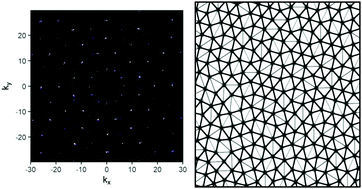Pattern formation in two-dimensional hard-core/soft-shell systems with variable soft shell profiles†
Abstract
Hard-core/soft shell (HCSS) particles have been shown to self-assemble into a remarkably rich variety of structures under compression due to the simple interplay between the hard-core and soft-shoulder length scales in their interactions. Most studies in this area model the soft shell interaction as a square shoulder potential. Although appealing from a theoretical point of view, the potential is physically unrealistic because there is no repulsive force in the soft shell regime, unlike in experimental HCSS systems. To make the model more realistic, here we consider HCSS particles with a range of soft shell potential profiles beyond the standard square shoulder form and study the model using both minimum energy calculations and Monte Carlo simulations. We find that by tuning density and the soft shell profile, HCSS particles in the thin shell regime (i.e., shell to core ratio  ) can form a large range of structures, including hexagons, chains, squares, rhomboids and two distinct zig-zag structures. Furthermore, by tuning the density and r1/r0, we find that HCSS particles with experimentally realistic linear ramp soft shoulder repulsions can form honeycombs and quasicrystals with 10-fold and 12-fold symmetry. Our study therefore suggests the exciting possibility of fabricating these exotic 2D structures experimentally through colloidal self-assembly.
) can form a large range of structures, including hexagons, chains, squares, rhomboids and two distinct zig-zag structures. Furthermore, by tuning the density and r1/r0, we find that HCSS particles with experimentally realistic linear ramp soft shoulder repulsions can form honeycombs and quasicrystals with 10-fold and 12-fold symmetry. Our study therefore suggests the exciting possibility of fabricating these exotic 2D structures experimentally through colloidal self-assembly.



 Please wait while we load your content...
Please wait while we load your content...